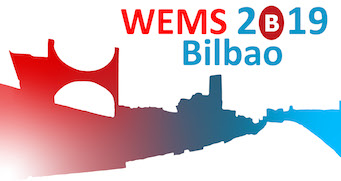Speaker
Description
Irradiating with charged particles can result in the build-up of a net charge in the irradiated material if the range of the particles is shorter than the shortest dimension of the material. This results in a net stored charge in the material, and may ultimately lead to charge break-down. The phenomenon is often observed in insulators or wide-band gap semi-conductor materials (e.g. Blaise and Le Gressus, 2018). Charge imbalance has been investigated using Optically Stimulated Luminescence (OSL); this technique gives indirect information on trapped electrons and holes in a material (Autzen et al., 2018). These experiments show that the luminescence response decreases at large doses when irradiating with 200 keV electrons, possibly as a result of changes in hole populations as excess electrons combine with trapped holes. This hypothesis is supported by GEANT4 modelling which shows that there is a significant net deposition of excess electrons during such irradiations.
Our interest is to study the phenomenon of possible charge build up in the wide-bandgap materials such as feldspar and quartz (SiO2). The internal charge is difficult to measure, but may have implications for the emission Mössbauer spectroscopy performed at ISOLDE/CERN.
It is hypothesised that the observed fluence-dependent ratio of Fe2+/Fe3+ in ZnO (Mølholt et al., 2009) is caused by charge imbalance. This ratio stabilises after a certain fluence (dose), possibly because of a lack of available electrons to compensate for the extra induced positive charge (charge imbalance), and not as a result of damage-induced vacancies as proposed earlier. If it is caused by unbalanced charge, subsequent electron beam irradiations would be expected to change the ratio. On the other hand reducing the mobility of vacancies with low temperature would point towards the damage-induced mechanism.
Our interest is to discuss possible emission Mössbauer experiments in order to stimulate charge imbalance and investigate resulting effects. One way to promote charge imbalance is by post e-beam irradiation, but a better solution could be with an on-line electron gun irradiation during implantation at ISOLDE. PMMA (plastic) may be a good test-system, since its properties are known to allow charge build-up and subsequent break-down, but minerals such as K-feldspar and ZnO are also potential targets.
G. Blaise, and C. Le Gressus, Electron-trapping and energy localization in insulating materials. Technological impact of space charge electron-beam characterization, AIP Advances 8:2018:095228
M. Autzen, A. S. Murray, G. Guérin, L. Baly, C. Ankjærgaard, M. Bailey, M. Jain, J.-P. Buylaert, Luminescence dosimetry: Does charge imbalance matter? Radiation Measurements 120(15):2018:26-32
T. E. Mølholt, R. Mantovan, H. P. Gunnlaugsson, K. Bharuth-Ram, M. Fanciulli, H. P. Gíslason, K. Johnston, Y. Kobayashi, G. Langouche, H. Masenda, D. Naidoo, S. Ólafsson, R. Sielemann, G. Weyer, Temperature and dose dependence of defect complex formation with ion-implanted Mn/Fe in ZnO, Physica B 404:2009:4820-4822,http://dx.doi.org/10.1016/j.physb.2009.08.187.




